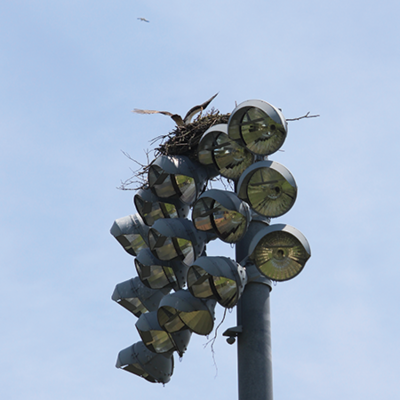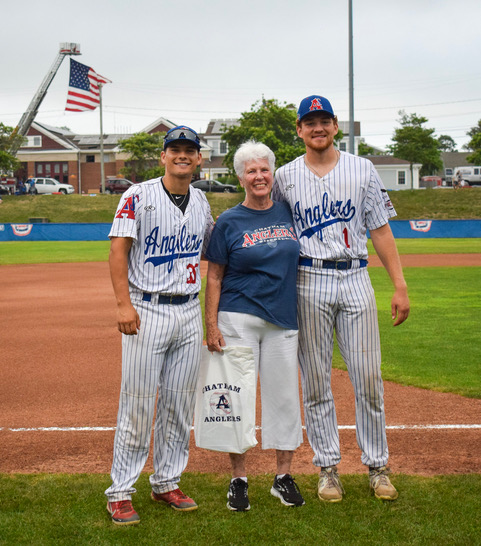Anglers News« Back to 2022 News Archives |
Behind the 'majestic birds' with the best seats at Veterans Field

A jumble of twigs and branches form a nest down the third base line, adjacent to the Chatham bullpen and atop one of the eight light towers at Veterans Field. To a family of ospreys, this cluster is home.
Sometimes, the ospreys take a short trip from their house to hover above left field, using the breeze from Oyster Pond to stay in place. They drop off gifts near the Chatham dugout, like disheveled herring guts ' which a curious kid might pick up with a stick ' or actual droppings, which could fall on you twice in one week if you're Chatham manager Tom Holliday.
The ospreys are the Anglers' most consistent fans, spectating every batting practice, youth clinic and game. Other osprey families spectate other teams. One watches Hyannis on a light tower near the first base line at McKeon Park. Another lays its claim along the third base line at Orleans' Eldredge Park. The birds that have been synonymous with summers on Cape Cod now provide an extra layer of entertainment between at-bats.
Roughly 50 years ago though, ospreys were almost 'locally extinct,' according to Stephanie Ellis, the executive director at Wild Care. Only two breeding pairs existed on Cape Cod.
The existence of dichlorodiphenyltrichloroethane (DDT), an insecticide used to get rid of mosquitoes and flies, was the leading cause for the disappearance of ospreys, according to David Clapp, a former member of Massachusetts Audubon Society and osprey expert. The use of DDT was most prevalent after World War II, poisoning the water that herring swam and, as a result, harming the ospreys who ate the fish. DDT was banned in 1972.
'That was a big eye-opener for environmentalism in the beginning of the control of pesticides and things like that,' Clapp said. 'The birds were no longer singing because they were dying off.'
The osprey population has increased exponentially since the 1970s, and Cape Cod currently has the highest concentration of the bird throughout the summer, Ellis said. Ospreys arrive in the area around the start of the CCBL season before leaving in September or October.
Younger ospreys travel from as far as the Maracaibo basin in Venezuela, where they spend almost two years in migration, while older ospreys fly from the Florida coast. Whatever age the ospreys are, they nest within 20 miles from the place they were born.
Ospreys continue to return to Cape Cod because of the immense population of forage fish like herring, Clapp said. Male ospreys are responsible for gutting the fish, using branches near their nest as a cutting board. Female ospreys incubate the eggs in the nests, which can be found on top of designed osprey poles.
Clapp said Gil Fernandez built the first osprey poles in the 1970s, starting on the banks of the Westport River, located near the Massachusetts-Rhode Island border. Mass Autobahn started putting poles in Cotuit and Osterville in 1977. The poles, which have a wooden platform at the top to hold a nest, can now be found in backyards, coastlines and conservation property.
'The ospreys were being adopted by the communities, like the town of Chatham,' Clapp said. 'People look forward to their return like it's the swallows of Capistrano.'
The birds have become more creative, nesting on electric poles, cell towers or light fixtures around the Cape. They prefer to nest facing away from the woods, Ellis said, to have a better eye on potential predators like great horned owls. Ellis added that they prefer the double cross arms on utility poles, which provide the ideal base for a nest.
Utility poles can lead to a variety of problems though, including nest fires, entanglement or short circuits, which can electrocute the birds. Ellis said rescue workers wish the ospreys would return to nesting in trees for their own safety, but there aren't enough. The ospreys declined to comment.
Zak Mertz, the executive director at the Birdsey Cape Wildlife Center, said it takes a village to look over ospreys. Because of the height of their nests in places like floodlights or utility poles, rescue organizations rely on local fire departments or Eversource Energy, the leading electric services company in the area, for help.
Fire departments supply the ladders and tools necessary to untrap ospreys that are tangled or put them back into their nests if they've fallen out. Eversource has been responsible for creating alternate platforms too, Ellis said.
'If an osprey doesn't have a nest or chicks and is in a problem area, Eversource will remove the nest and place a deterrent, and in some circumstances place an alternate platform,' Ellis said. 'A lot of people think of Eversource as the bad guy, but they do so much to be proactive and make it so we can all live together.'
Ospreys that are injured as a result of trauma like crashing into cars are immediately brought into rehab centers, Mertz said. Ellis said they try to aid the birds as fast as possible, especially with chicks toward the end of the season since they need to learn the hunting skills necessary for migration.
Mertz added that if a chick loses its family for any reason, animal hospitals bring it to a family who has a chick of the similar age, something they refer to as a 'foster nest.'
Still, Mertz said that they can't help an animal that's run into a problem unless a person cares enough to ask for help. While the banning of DDT keeps ospreys healthy, the communities embracing the animals as a part of the summer experience will keep their population growing, and maintain their fandom for CCBL teams.
'It really adds to the ballgame to watch these majestic birds come in and out,' Clapp said.

